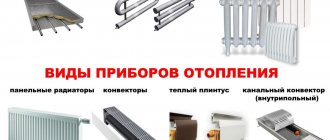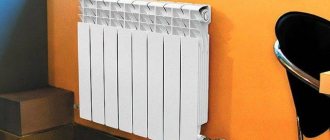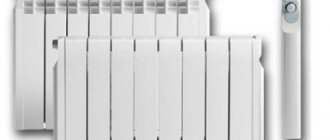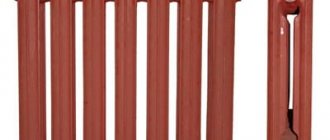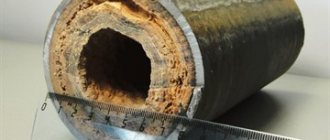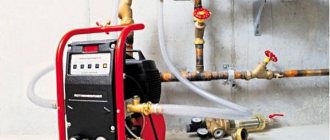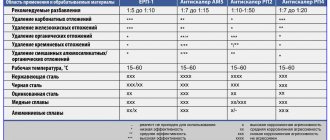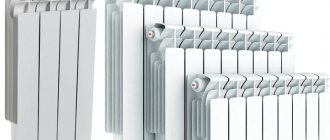Flushing aluminum heating radiators is necessary to remove lime deposits on the internal walls of the device or to prevent their formation. Such deposits are most often formed due to the fact that the water contains substances such as magnesium, calcium, various salts, iron, sodium and other elements of inorganic origin. Let's figure out how to wash an aluminum heating radiator.
Flushing an aluminum radiator
How to wash and repair an aluminum heating radiator - washing methods
Flushing aluminum heating radiators is necessary to remove lime deposits on the internal walls of the device or to prevent their formation.
Such deposits are most often formed due to the fact that the water contains substances such as magnesium, calcium, various salts, iron, sodium and other elements of inorganic origin. Let's figure out how to wash an aluminum heating radiator. Flushing an aluminum radiator
- Washing methods
- Flushing radiators with chemicals
Washing methods
There are several main ways by which you can flush a heating radiator. The use of one method or another depends on how large the deposits are on the inner walls of the radiators.
Most often, deposits of components such as:
- Iron oxide, it is contained in sediments from 15 to 35%;
- Magnesium and calcium oxides can reach 35-65%;
- Copper and zinc oxides – from 2 to 6%;
- Trivalent sulfur oxide can range from 2.5 to 4%.
Regular flushing must be carried out for any system, regardless of what operating parameters it has.
If the radiators have been flushed for a long time, then it must be done as soon as possible. Scale and deposits will form on the internal walls of the device, regardless of what material the radiators are made of.
Deposits in heating pipes
It must be remembered that scale and deposits will reduce the efficiency of the heating system, since the internal diameter of pipes and other components will be slightly reduced. Just one millimeter of such deposits can reduce the performance of the heating system by 10-15%.
This will contribute to the fact that the costs of maintaining the most optimal and comfortable temperature regime will also increase. Sometimes deposits can cause an emergency, and then it will be necessary to replace some components of the heating system, so it is better to carry out regular flushing.
This procedure must be performed at least once during the heating season.
Maintenance must be carried out once a year, even if the heating radiators were installed recently.
How to flush an aluminum radiator effectively? When choosing a cleaning agent, you must be extremely careful, since some products that contain chemical elements can affect not only deposits and scale, but also the material from which radiators or other elements of the heating system are made. If you do not want to make a fatal mistake and subsequent repair of an aluminum heating radiator, and the entire system, then you can invite a specialist who will help you select the most suitable reagents and tell you in what proportions they need to be used.
Cleaning the radiator
Flushing radiators with chemicals
Today, there are several methods for good and effective flushing of heating radiators and other components of the heating system. The most common method is the use of chemicals that contain various alkalis and acids.
This method of flushing is good because to use it there is no need to disassemble the heating system. This method can be used at any time, even during the heating season, and not only when an operation such as repairing an aluminum heating radiator is required. Thanks to the chemical solution, almost all scale is removed from the system. First, the chemical composition dissolves the deposits, and then they are washed out of the system.
Device for chemical cleaning of heating radiators
Many manufacturers do not reveal the secret of the proportions in which the various elements are contained in the composition of the product.
Chemical flushing is not only an inexpensive, but also an effective way to clean your heating system.
However, this method also has several disadvantages. The first disadvantage is that such a solution is somewhat toxic. Caution must also be exercised if a concentrate wash is used. An incorrect proportion can also damage the components of the heating system.
Another method for flushing aluminum heating radiators is the hydrodynamic method. Its peculiarity is that scale is removed using a thin stream of water, which is supplied under a certain pressure. Water is supplied through special nozzles.
Cleaning methods
Heating batteries can be washed using the following methods:
Which method to use in a particular situation depends on the degree of contamination. to use softened water that as a coolant .
will remain clean even after years of use
Hydraulic flushing
The advantage is that it can be cleaned at any time, including the heating season. To clean, you need to run running water through the system.
Sequencing:
- connect a hose leading to the sewer to the drain tap;
- open the feed tap by connecting water (preferably hot);
- water with rust and other contaminants should come out of the hose connected to the sewer;
- complete the procedure when clean water comes out.
It is advisable to repeat the procedure 2-3 times , since dirt can be driven to the inner walls by the flow of water. In many homes, the system is not connected to the water supply.

In this case, to supply water to the batteries, you need to use a pump or pump . This is a fairly effective and system-friendly cleaning method.
By using it regularly, you will eliminate the need for more complex cleaning. But, if there is already too much pollution, you will have to resort to more effective methods.
Hydropneumatic cleaning
The technique is similar to the previous one, but also involves the use of pressurized air. A car or other sufficiently powerful compressor is suitable for generating air flow.
Air should be supplied to heating devices not constantly, but intermittently. This will create a pulsating effect that breaks up even heavy deposits.
The downside is the water hammer to which heating devices are exposed. They can damage weak areas of the system. But this also leads to an advantage - you will identify potential emergency areas and be able to repair them.
Dry cleaning
This method involves the use of various chemicals - from household to specialized ones. It is recommended to purchase a special liquid; there are quite a lot of them on the market.
If this is not possible, you can resort to folk remedies :
Experts recommend using citric acid . It effectively copes with both scale and rust. Vinegar also works well
Usually the batteries have to be removed. If there is a bypass in the piping, dismantling can be done even during the heating season.
Cleanliness is the key to equipment reliability! How to clean an aluminum heating radiator in an apartment?
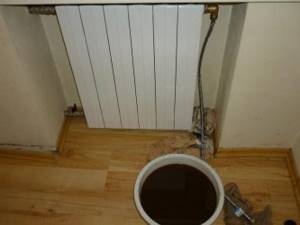
The heating system often fails due to its clogging with various particles and due to plaque deposits on the inner surface of the radiator.
Preventative cleaning of batteries should be carried out at least once a year, and general cleaning once every 5–7 years or if necessary . Regular washing will ensure the longevity of the equipment and the efficiency of their operation.
ontakte
Odnoklassniki
Heating systems in private houses , as a rule, become dirty much less often than radiators in apartment buildings. It is advisable to use water in the heating system that has been purified using filters , which ensures high heating efficiency throughout the entire heating season.
The main signs of the need to clean aluminum radiators:
- Increased energy consumption for the normal functioning of batteries and the system as a whole.
- Partial heating . A hot top and cold bottom indicate a significant blockage.
- When the system starts up, the battery heats up much more slowly than similar equipment in other rooms.
How and with what to clean aluminum radiators
Depending on the expected degree of contamination of the batteries and the structural features of the heating system, you should choose the option that is optimal for gentle and high-quality cleaning.
Consequences of sediments
This is fraught with the fact that even the smallest build-up can reduce the power of the battery, and, consequently, increase the cost of maintaining heat in the house. Even with a minimal decrease in diameter, the pressure in the heating system increases, which can lead to water hammer in the heating, and, as a result, repair or replacement of the batteries will be necessary.
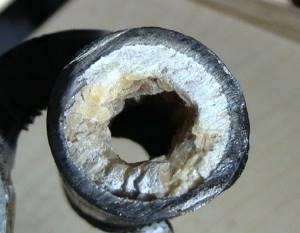
Deposits within the system
How to clean an aluminum car heater radiator
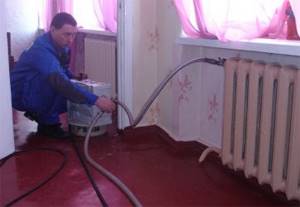
July 26, 2018
If after several years of operation the heater of your car begins to heat noticeably worse, the matter is most likely due to a decrease in the throughput of the heater radiator. In this case, it needs to be washed. However, you should be careful when performing this operation on an aluminum heat exchanger, since not all products are equally safe for aluminum.
Am I to blame?
There may be other reasons for the fact that the stove no longer heats as efficiently as the one mentioned above. Over time, the heat exchanger honeycombs and cabin filter become clogged. If the latter is still available for maintenance, then cleaning the outer surface of the radiator is a real epic, since this requires disassembling almost the entire front panel.
Therefore, you should make sure that the cause is precisely deposits inside the stove radiator. The simplest verification method is based on the following. The new device heats the entire surface with the same intensity. When the tubes begin to become overgrown with dirt and sludge, the temperature decreases as the coolant moves, just as a person’s feet become cold with blood vessels clogged with cholesterol.
To check, start the engine and let it warm up to operating temperature. Then we open all four diffusers on the front surface of the dashboard and turn on the heater to maximum. Using the palm of your hand, compare the temperature of the air leaving different heater channels. It’s a good idea to use a temperature measuring device - a pyrometer. If the air from the supply tank is noticeably warmer, our suspicions are confirmed and the radiator must be flushed.
A little theory
The process of washing products made of aluminum and its alloys is not so simple. Products usually used for cleaning copper radiators are dangerous for aluminum. This is where the savings come from for automakers who are replacing copper with aluminum everywhere. Therefore, you should choose wisely when choosing flushing agents and liquids.
Battery cleaning brushes and sponges
To remove old stains, the following will help:
- A toothbrush, brush or narrow paint brush with stiff bristles. They are able to crawl into the most remote corners of the radiator.
- Sponge. If you attach it to a long ruler, it can also clean hard-to-reach places.
- Rubber glove. You need to put it on your hand and wash it well with laundry soap. Then rub off stubborn stains on the heater using your fingers. Can be replaced with old cut-off tights or socks.
- Dishwashing brush. Use this brush to clean the battery. They are sold in hardware stores and have a comfortable long handle.
- Spray. In order to wash the inside of old batteries, you need to add detergent to the spray bottle and spray the dirt. Wait a while and wipe the soaked areas with a damp cloth.
Before using cleaning chemicals, you should carefully read the composition. Since it may contain aggressive active substances that can easily destroy the surface of the radiator.
